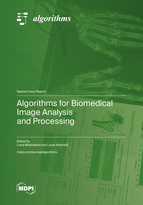Algorithms for Biomedical Image Analysis and Processing
A special issue of Algorithms (ISSN 1999-4893). This special issue belongs to the section "Algorithms for Multidisciplinary Applications".
Deadline for manuscript submissions: closed (15 June 2023) | Viewed by 25086
Special Issue Editors
Interests: computational data science; image processing; omics and imaging data integration
Special Issues, Collections and Topics in MDPI journals
Interests: numerical methods; image processing; high-performance scientific computing
Special Issues, Collections and Topics in MDPI journals
Special Issue Information
Dear Colleagues,
Biomedical imaging is a broad field concerning image capture for diagnostic and therapeutic purposes. Biomedical imaging technologies utilize X-rays (CT scans), magnetism (MRI), sound (ultrasound), radioactive pharmaceuticals (nuclear medicine: SPECT, PET), or light (endoscopy, OCT). Algorithms for processing and analyzing biomedical images are commonly used to visualize anatomical structures or assess the functionality of human organs, point out pathological regions, analyze biological and metabolic processes, set therapy plans, and carry out image-guided surgery. At a different scale, microscopy images are generally produced using light microscopes, which provide structural and temporal information about biological specimens. In the most widely used light microscopy techniques, light is transmitted from a source on the opposite side of the specimen to the objective lens. By contrast, fluorescence microscopy uses the reflected light of the specimen. Microscopy imaging requires methods for quantitative, unbiased, and reproducible extraction of meaningful measurements to quantify morphological properties and investigate intra- and intercellular dynamics. New technologies have been developed to address this need, such as microscopy-based screening, sequencing, and imaging, with automated analysis (including high-throughput screening and high-content screening), where basic image processing algorithms (e.g., denoising and segmentation) are fundamental tasks.
The large number of applications that rely on biomedical images increases the demand for efficient, accurate, and reliable algorithms for biomedical image processing and analysis, especially with the rising complexity of imaging technologies and the huge number of images to be processed.
This Special Issue aims to bring together both original research articles and topical reviews on algorithms for biomedical image processing and analysis techniques. Some basic techniques include deblurring, noise cleaning, filtering, 3D reconstruction from projection, segmentation, etc.
Submissions are welcome for algorithms based both on traditional approaches and on new machine learning techniques. Potential topics include but are not limited to:
- Medical image analysis and processing;
- Microscopy and histology image analysis and processing;
- Computer-aided detection;
- Computer-aided diagnosis;
- Imaging biomarkers;
- Reconstruction in emission tomography;
- Computerized cell tracking;
- Machine and deep learning for biomedical imaging;
- Methods for combined imaging technologies.
Dr. Lucia Maddalena
Dr. Laura Antonelli
Guest Editors
Manuscript Submission Information
Manuscripts should be submitted online at www.mdpi.com by registering and logging in to this website. Once you are registered, click here to go to the submission form. Manuscripts can be submitted until the deadline. All submissions that pass pre-check are peer-reviewed. Accepted papers will be published continuously in the journal (as soon as accepted) and will be listed together on the special issue website. Research articles, review articles as well as short communications are invited. For planned papers, a title and short abstract (about 100 words) can be sent to the Editorial Office for announcement on this website.
Submitted manuscripts should not have been published previously, nor be under consideration for publication elsewhere (except conference proceedings papers). All manuscripts are thoroughly refereed through a single-blind peer-review process. A guide for authors and other relevant information for submission of manuscripts is available on the Instructions for Authors page. Algorithms is an international peer-reviewed open access monthly journal published by MDPI.
Please visit the Instructions for Authors page before submitting a manuscript. The Article Processing Charge (APC) for publication in this open access journal is 1600 CHF (Swiss Francs). Submitted papers should be well formatted and use good English. Authors may use MDPI's English editing service prior to publication or during author revisions.
Keywords
- deblurring
- denoising
- segmentation
- classification
- detection
- tracking
- lineage







